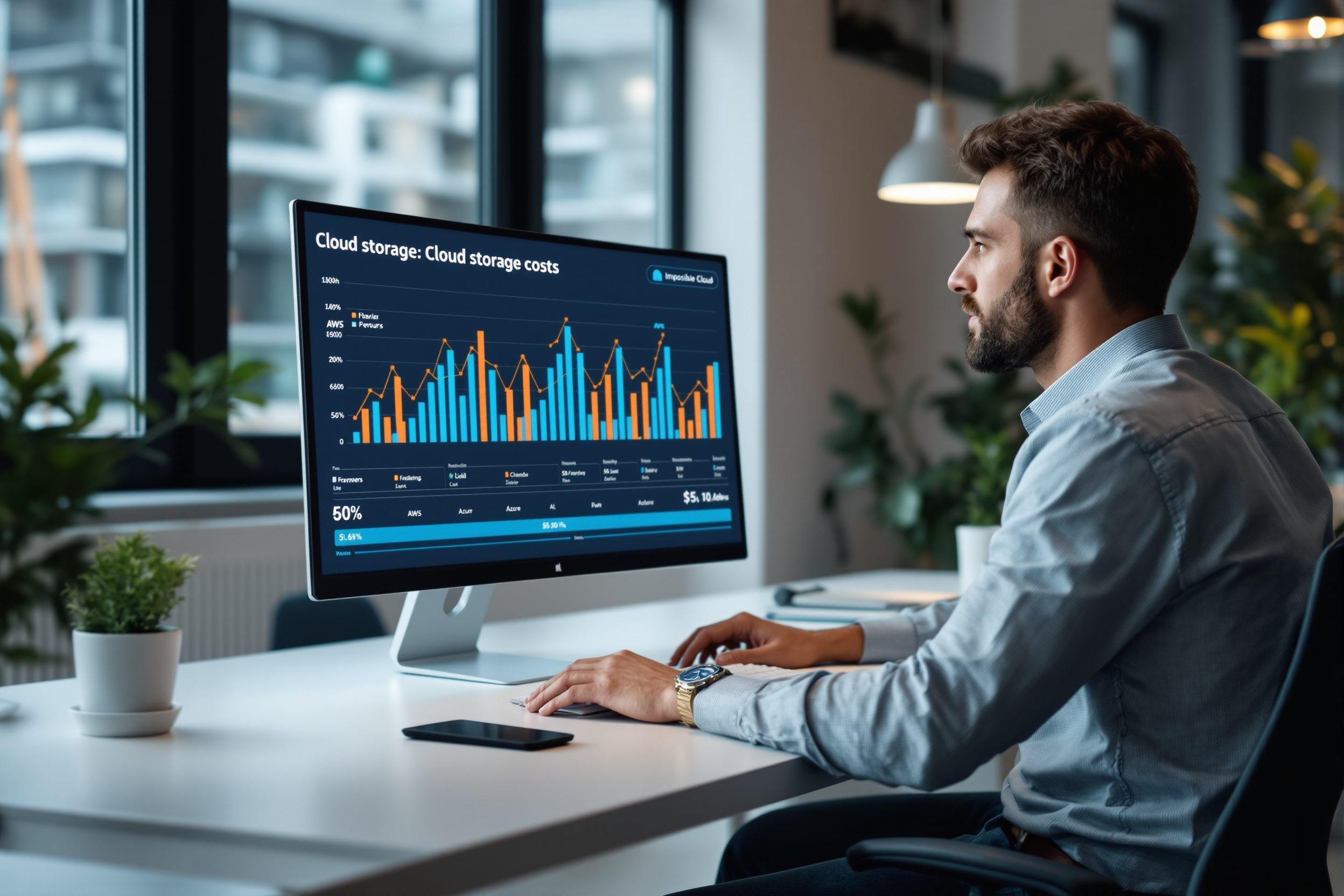Topics on this page
For IT leaders across the UK and Europe, managing cloud storage budgets has become a significant challenge. A staggering 56% of European organisations exceeded their cloud storage budgets in the last year, with nearly half of all billing attributed to variable usage fees, not just storage capacity. These unpredictable costs, particularly data egress fees, create financial uncertainty and hinder strategic initiatives. This article explores how a model built on transparent cloud pricing with no egress fees provides a stable, predictable alternative. It details a path to achieving both financial control and digital sovereignty, aligning with Europe's evolving regulatory landscape.
Key Takeaways
- Transparent cloud pricing with no egress or API fees is essential for budget predictability, as hidden charges cause 56% of European firms to overspend.
- Storing data in EU-only data centers with a European provider is critical for GDPR compliance and digital sovereignty, a priority for 84% of EU organizations.
- An "Always-Hot" storage architecture with full S3 compatibility simplifies operations, accelerates restores, and provides robust ransomware protection with immutable backups.
The Hidden Costs Crippling Cloud Budgets
Many European businesses find that up to 47% of their cloud storage bill consists of variable usage and access fees. These charges, which include costs for API calls and data retrieval, make accurate budget forecasting nearly impossible for 90% of companies. In Germany, the situation is even more acute, with 66% of organisations reporting budget overruns due to these complex fee structures.
Egress fees alone cause 55% of European firms to delay important IT projects. This financial friction directly impacts innovation and operational agility, turning the cloud from a business enabler into a budget inhibitor. The complexity of tiered storage models adds another layer of unpredictable expense, with restore delays and hidden retrieval costs disrupting critical workflows. This forces a re-evaluation of cloud cost traps.
Predictable by Design: The Power of a Transparent Pricing Model
A model based on transparent cloud pricing with no egress fees offers a direct solution to budget volatility. By eliminating charges for data egress, API calls, and minimum storage durations, businesses gain complete cost predictability. This approach ensures the price you see is the price you pay, simplifying financial planning for 100% of your stored data. For MSPs, this predictability is a game-changer, allowing them to build services with stable, defensible margins.
This economic clarity is a primary driver for businesses seeking European cloud alternatives. It removes the risk of vendor lock-in, where 41% of companies feel trapped by the high cost and complexity of migration. An all-inclusive pricing model provides the freedom to move and use data as needed, fostering a healthier, more competitive cloud market. You can explore the benefits of this transparent pricing model.
Strengthening Sovereignty with EU-Centric Storage
Data sovereignty is a top priority for European businesses, with 84% planning to use sovereign cloud solutions. Storing data exclusively in European data centers is fundamental to meeting GDPR's strict data residency requirements. This ensures data is governed by EU law, effectively avoiding exposure to foreign legislation like the US CLOUD Act. This is a critical consideration for any organisation handling personal data.
A truly sovereign cloud provides more than just location; it offers country-level geofencing capabilities. This allows businesses to restrict data to specific EU nations, providing granular control for regulated industries. This level of control is a key differentiator for maintaining compliance and customer trust. Choosing an EU-owned and operated provider reinforces this commitment, ensuring both physical data residency and legal jurisdiction remain firmly within Europe. Learn more about sovereign cloud alternatives.
Enterprise-Ready Architecture: Performance Without Tiers
Modern data workloads demand consistent performance, a feature often compromised by complex storage tiers. An "Always-Hot" object storage architecture eliminates this issue entirely. It ensures 100% of your data is immediately accessible without retrieval delays or rehydration fees. This model simplifies operations and guarantees predictable performance for backup, recovery, and analytics.
This architectural choice delivers key benefits for enterprise IT:
- Full S3 API Compatibility: Ensures existing tools, scripts, and applications work without modification, protecting technology investments and reducing migration risk by 100%.
- Immutable Storage: Utilises Object Lock to create tamper-proof data copies, providing a robust defense against ransomware attacks for 100% of protected objects.
- Resilience and Availability: Built to eliminate single points of failure, ensuring high availability and data integrity across multiple certified European data centers.
- Simplified Management: Removes the need for complex lifecycle policies, reducing the risk of configuration errors and unexpected costs by at least 15%.
This approach provides the reliability and ease of use required for mission-critical applications, making it a superior choice over fragile, tiered systems. Discover the advantages of our S3 compatible storage.
Future-Proofing Compliance for the EU Data Act and NIS-2
Forthcoming EU regulations intensify the need for compliant, transparent cloud partners. The EU Data Act, applying from September 2025, mandates easier cloud switching and will phase out egress fees entirely by January 2027. A provider already offering transparent cloud pricing with no egress fees aligns perfectly with this regulation, demonstrating a commitment to data portability and eliminating lock-in from day one.
Similarly, the NIS-2 Directive requires organisations in 18 critical sectors to implement robust cybersecurity risk management. This includes supply chain security, making your choice of cloud provider a direct compliance issue. A platform with built-in features like multi-layer encryption, immutable storage, and IAM with MFA helps meet these stringent security requirements. This proactive stance on compliance provides a clear advantage for businesses preparing for these new legal frameworks.
An Engine for Partner Growth: Enabling the Channel
For MSPs, resellers, and system integrators, predictable margins are the foundation of a successful business. A storage model with zero egress and API fees is predictable by design. This stability allows partners to craft competitive Backup-as-a-Service and archiving solutions with confidence. Onboarding is streamlined, taking only minutes to get new clients running.
The partner platform is built for efficiency and scale. Here is what it includes:
- Multi-Tenant Console: Manage multiple clients securely with role-based access control (RBAC) and multi-factor authentication (MFA).
- Full Automation: Utilise a comprehensive API and CLI to integrate storage management into existing workflows and scripts.
- Clear Reporting: Access detailed reports for streamlined client billing and resource management.
- Growing Distribution: Expanded access through distributors like api in Germany and Northamber plc in the UK provide local support for hundreds of resellers.
This partner-centric approach transforms cloud storage from a cost center into a reliable revenue stream. It's a key reason to explore our cost structure.
Making the Switch: A Practical Path to Predictable Costs
Migrating to a cloud with transparent pricing is a straightforward process designed to minimize disruption. Thanks to full S3 API compatibility, your existing applications and data management tools can connect with zero code changes. The process involves just a few steps to redirect your data flows to the new, cost-effective platform.
A typical migration takes less than one business day to configure and test. Follow this simple checklist to start saving:
- Update Endpoint Credentials: Change the S3 endpoint URL and access keys in your backup software or application configuration.
- Replicate Policies: Recreate any bucket policies, lifecycle rules, and IAM permissions using the intuitive console or API.
- Run a Test Backup: Perform a small-scale backup or data transfer to validate the connection and performance, ensuring it meets your RPO/RTO targets.
- Initiate Full Migration: Begin the bulk data transfer, monitoring progress through the console.
- Verify with a Test Restore: Conduct a test restore of a critical dataset to confirm end-to-end data integrity and accessibility.
This seamless transition allows you to quickly realize the benefits of a storage architecture with no egress fees. Start your journey towards affordable object storage today.
More Links
Bitkom provides charts and analysis related to cloud computing.
KPMG offers insights into the cloud market and trends.
The Federal Statistical Office (Destatis) provides statistics related to cloud usage.
DIW Berlin discusses how cloud solutions can increase productivity.
MIT Sloan discusses how GDPR reduced firms' data and computation use.
FAQ
What does 'transparent cloud pricing no egress fees' actually mean?
It means the pricing model is simple and all-inclusive. You pay for the storage you use without any extra charges for data transfers out of the cloud (egress), API requests, or minimum storage periods. This eliminates surprise costs and makes your monthly bill 100% predictable.
Is your service suitable for enterprise backup and disaster recovery?
Yes. Our platform is designed for these exact use cases. With features like an 'Always-Hot' architecture for fast restores, immutable storage for ransomware protection, and full compatibility with leading backup tools, it provides a resilient and cost-effective solution for enterprise data protection.
How do you ensure my data stays within the EU?
We operate exclusively in certified European data centers and are a European company. We offer country-level geofencing, allowing you to lock your data into specific EU regions to meet strict data sovereignty and regulatory requirements like GDPR.
Can I migrate my data from another S3 provider easily?
Absolutely. Because we are fully S3 API compatible, migration is simple. You only need to update the endpoint and credentials in your existing tools or scripts. No code rewrites or complex data transformations are required.
What benefits do you offer for MSPs and channel partners?
We provide a partner-ready platform with a multi-tenant console, full automation via API/CLI, and clear reporting. The predictable pricing model with no egress fees allows partners to build services with stable, high margins. We also offer local support through distributors like api (Germany) and Northamber plc (UK).
How does your architecture compare to tiered storage models?
Our 'Always-Hot' model is simpler and more efficient. Unlike tiered models that introduce delays and fees for accessing archived data, all our data is instantly available. This eliminates operational complexity, prevents unexpected restore costs, and ensures your applications always perform predictably.




.png)
.png)
.png)
.png)



.png)




%201.png)